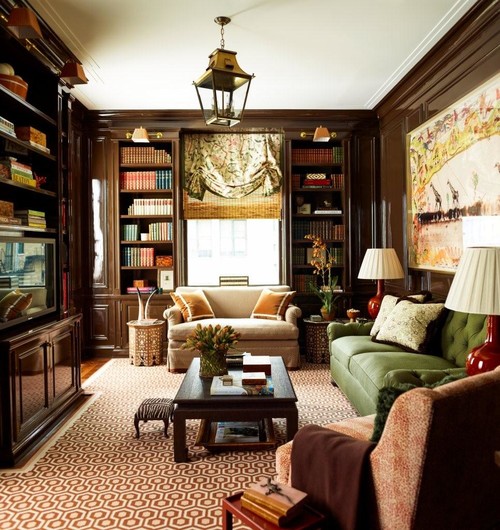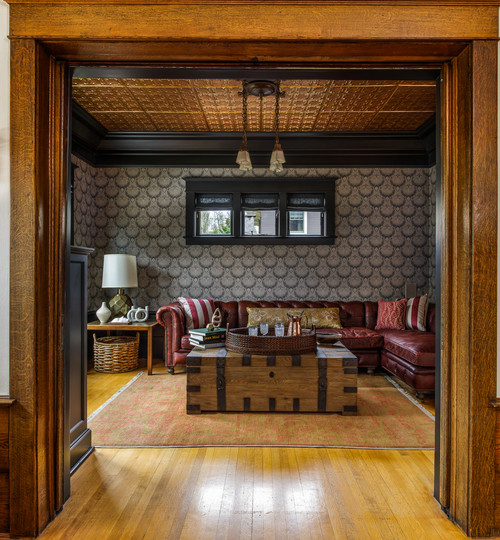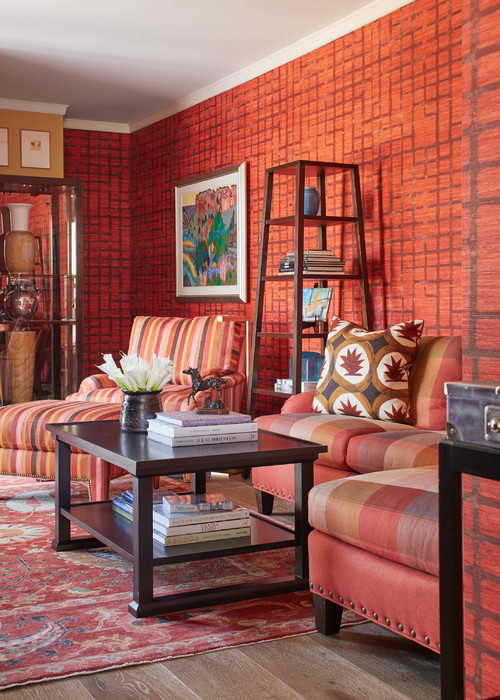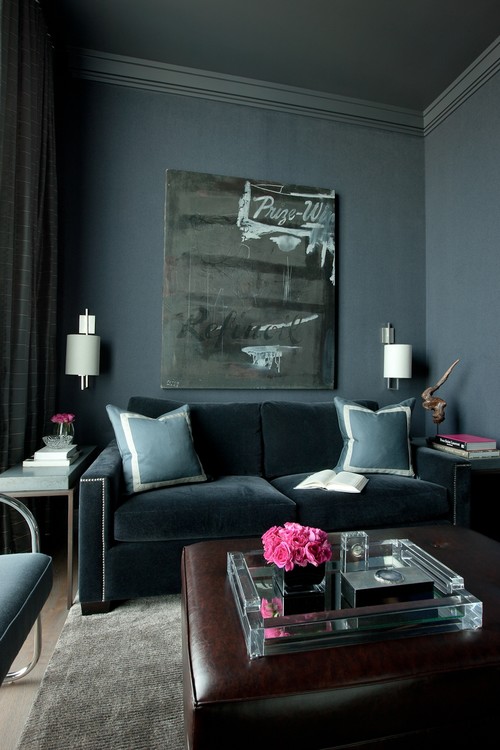We’ve all heard of minimalism, but what about its opposite: maximalism? You may have to unlearn some of what you’ve read over the years to embrace this growing trend, but it could be very worth it. Join me in discovering what maximalism is all about, and how to do it right.

Maximalism is by no means a modern trend; maximalists have existed across the globe for centuries. Wealthy people throughout history have practiced forms of maximalism as ways to showcase their riches. One of the most poignant examples of this practice can be traced to 16th-century cabinets of curiosities. The items placed on display would vary—first, animal specimens were popular, while in later years, individuals chose to highlight artwork and other goods. Cabinets of curiosities were like small, private museums that were stuffed top to bottom with treasures. In addition, the ornate style of furniture and placement of it amongst objects in every time period from renaissance to victorian eras is a form of maximalism. It is a fairly recent trend towards minimalism that has brought our design tendencies to where they are today. The Victorians loved the material world, and they lived during a time when consumable goods became much more accessible and affordable. Every inch of their homes was covered with some decorative element from wallpaper to rugs to drapery to decorative accessories. As a culture, they invested in the idea that each person had their own personality and [the] maximalist element of their homes reflected an attempt to showcase their private selves to visitors.
See 10 excellent maximalist interior design examples here.
The 1930s Hollywood Regency style, for example, was all about glam and glitz. Taking inspiration from Rococo and Neoclassicism — as well as Greek, Egyptian, and Asian culture — the look included gold accents, statement lighting, and satin upholstery. These loud design choices definitely echo today’s maximalist decor (although some of the patterns and antique art associated with this look might remind you of traditional style).Let’s fast forward a little. Pattern & Decoration, a visual art movement from the 1970s, is also significant to look at. The movement “saw the sensuous, pleasurable, and ornamental as every bit as legitimate, complex, and sophisticated as the icons of modernism,” according to Artsy. It also focused on championing the importance of artwork outside of a male- and Western-centric focus. Pieces in this vein include elements like bold colors, floral patterns, embroidered elements, and collage. In 1981, the Memphis Design group kicked off its first exhibition as a reaction to modern decor rules. The designs included saturated colors, geometric shapes, and patterns like terrazzo, bold stripes, and cut-outs. High and low were mixed together, such as in pieces that combined marble with glass or laminate.
Why is Maximalism Popular Again?
The reemergence of design trends is a fascinating and indicative phenomenon. A lot of design trends of recent years, in both fashion and home decor, have incorporated bright colours, mixed patterns, funky lines and shapes, and an overall eclectic curation. In today’s decor, you can see the enduring popularity of maximalism in the resurgence of interest in Memphis Design. Founder Ettore Sottsass’s Ultrafragola mirror, for example, is an Instagram favorite. Major retailers and design influencers alike have embraced an eclectic approach to design, often mixing bright colors with quirky decor and patterned wallpaper. We’ve also noticed a lot of today’s maximalism veers towards a reinvention of European traditional decor. Spaces like New Orleans’ Maison de la Luz combine swanky lighting fixtures and classy furniture with bright artwork and Insta-friendly rugs. This boho maximalism look definitely shows a popular direction for the style. Of course, there are so many different ways to do maximalism, that could incorporate one, two or how ever many stylistic epochs you want.
Consumer culture also plays an important role in the rise (and fall… and rise again) of maximalist design. Come the 19th century, production capabilities were ramping up in the United States and beyond, and shopping became sport for Americans. Filling homes, which increasingly became larger in size, with decor that had little function beyond looking aesthetically pleasing was a sign of the times — and a sign of an upper middle class identity that came with the disposable income necessary to collect.
Why would an attraction to eclectic and more crowded walls and spaces arise in this particular moment? What is appealing to our culture and society about this style? In some ways, it feels evocative of a childlike way of curating space. Perhaps we are all seeking to return to our youth: representative of simpler times when we had freedom to express and act without the weight of global pandemics and global climate catastrophe on our minds. Maximalism seems to express a warmth, creative freedom, and abundance. In times when resources are literally scarce, finances are precarious, and a lot of isolation and sterility has coloured our existence, it makes perfect sense that we are seeking our maximalism.
How to do Maximalism right?
There are a few guidelines that can be followed in order to make your space look intentional. Along with things like mixing patterns and textiles, multiples are important. If the idea is “more is more,” don’t just place two candlesticks on your fireplace mantle, go all out and deck it out with twenty. Fill your walls with as much artwork as they will hold. Think your living room is complete with one statement chandelier? Think again — put up two or three. As long as you consider how the pieces will work together, you can fill your home with anything that brings you joy.
In order to achieve visual balance, which is necessary for a busy style such as this, be sure to pay attention to scale. A long sofa should be paired with a long coffee table. Keep furniture at roughly the same height. Visual balance can be achieved by pairing low-back chairs with shelves and artwork that go up to the ceiling. The placement of furniture can create visual symmetry as well. If you have a large headboard in the master bedroom, balance it with a large piece of artwork on the opposite wall. These steps are what will make your space feel cohesive and thoughtful rather than chaotic and sloppy.
1. Start with the Walls
In a maximalist home, a great way to pull everything together is with the walls. Putting up some kind of wallpaper or a bright colour on the wall will allow the entire room to feel like maximal heaven. While this may seem like too much to some, it is exactly this boldness that will take your room to the next level. Stunning wallpaper ideas can turn a room from blah to beautiful. Wallpaper is a brilliant way to add interest to your home and help distinguish areas, giving them purpose and personality, while belonging to an overall scheme. If you’re easing yourself into the world of wallpaper, perhaps start with the smallest room of the house – the powder room or cloakroom. There are no rules here; go bold and give the mini space a well-deserved design moment! If you’re not ready for the maximalist plunge, go for a smaller scale design to ease yourself into wallpaper. It’ll add texture and restrained elegance to any space, without feeling overwhelming. Browse through photos of maximalist spaces and you’ll notice one thing they all have in common—fun walls! We think an eclectic gallery wall is the best way to dip your toe into this trend. Don’t be intimidated—maximalist gallery walls are actually the easiest type of display to create because there is no wrong answer! You can mix-and-match styles of artwork, types of frames, and color palettes and it will still look good. We especially love mixing custom framed artwork, shadow boxes, and canvases with unexpected elements like masks, mirrors, plaques, and even small shelves.
2. Find Objects that Resonate
Maximalism’s flexible rules mean that when it comes to furniture, you can fill your home with what you love. Want a wingback chair next to a streamlined sofa? Go for it. Have your eye on that Greek revival credenza and glass mid-century modern coffee table? According to maximalism, they make the perfect pair. Again, the key to nailing the look is to carefully curate your pieces a little at a time. The whole point of this style is to have a home of things you love– those that bring you joy and are filled with happy memories. Take time to really scout out accessory items like side tables, lamps, and bookcases. If you love it, there is a place for it in your home. Maximalism creates space for all the things you collect in your travels to be featured and admired. It provides opportunity for you to collect strange and fantastic objects from wherever you go, and incorporate them into your home. Don’t just place them all on one shelf, but thoughtfully disperse them throughout your space to create a cohesive and rich environment to live in.
3. Think Textures
Pay attention to the interplay between the silhouettes, shapes, textures, and materials of your major furnishings as well. Maximalist design schemes work better when a balance exists between light and heavy pieces, so the room doesn’t feel closed-off or super uniform. This does not mean actual weight but visual weight. For example, if you have a bulky nightstand, offset it with a light and slim table lamp for balance. Texturally, maximalism is a great way to play with difference and create a visual tapestry. Pairing natural textures with sleek modern ones is a great way to create a dynamic and interesting space. Metallic accessories can add elegance and shine to a room. Combine cool tones such as silver and gunmetal with warm tones like copper and brass to create a unique look.
4. Don’t be afraid of Mixing Styles
Some interior design schools would say, stick to one or only a few styles or eras of design. In maximalism, the world and its many periods in design are truly your oyster. You can integrate victorian elements with midcentury, and art deco with scandinavian. It provides a true freedom to the design process, and allows all of theses styles to be in conversation. Because maximalism incorporates so many different styles, you don’t have to buy a bunch of new furniture to try the trend—phew! You can make your current pieces work by adding in the right accessories. If you have a simple grey sofa, layer on pillows in vibrant colors and eye-catching prints and toss on a throw blanket with a chunky texture or beautiful pattern. If your furniture still has a few good years left but could use a facelift, consider swapping out the legs for a more interesting set or having a slipcover made in a fun fabric.If you want to purchase furniture and accessories, start by browsing antique stores and consignment shops to discover unique pieces with history. Vintage items feel more special and they’re good for the planet! But whether you purchase new or vintage, try to step out of your comfort zone by experimenting with color and pattern.
5. Don’t over-clutter
A maximalist space doesn’t necessarily mean a jam-packed space. In order for your decor to feel intentional, try to be strategic about what you display and how you display it. Curation is key, and to do so, you should showcase items you love such as books, planters, and art but layer them using different heights or depth of field. It’s always a good idea to stagger items and objects to create a more dynamic composition.Building on the “curation is key” tip above, consider stowing items that don’t add anything decorative to the scheme of your room. Things like lotions, clothes, towels, and office supplies should be tucked away, as not to overwhelm the eye with “stuff.” That said, if you’re after a maximalist aesthetic, you can certainly put your collectibles on display and shop for statement-making storage pieces. There are all sorts of ways to create a maximalist room, but if you feel like yours is headed in the direction of “cluttered” rather than “creative,” you might be missing a narrative. Ask yourself things like: What is the theme or mood of the room? What do I want to feel or think of when stepping inside? Do all of the pieces add to that story, or are they just taking up space?
6. Go Big or Go Home
If your maximalist room is starting to feel a little too busy, negative space can be used to open up the design scheme a bit. Give objects the opportunity to be a star: Allow a few select pieces to have room to breathe and take center stage. With this approach, choosing large bold pieces is a great way to keep the maximalist feel, all the while creating visual focus and a sense of harmony and balance. Lighting, architecture, and function are a few of the plethora of elements to think about in terms of design. Certain room upgrades, such as hanging a large and lovely chandelier, may require professional light fixture installation near you to ensure it’s done safely. However, it can be so worth it to create that wow factor! Another way to do this is with one large central piece of furniture, like a coffee table.
7. Patterns
One of the tenets of maximalist style is the combination of patterns. However, it’s a fine line to walk in terms of execution. Olsen says that mixing patterns can be a process of trial and error, and surveying your scale is important. Confine some patterns to small areas and others to expansive spaces so the scales don’t compete. If you’re mixing patterns, just look at the scale of each pattern, and if you can tell that the floral is the same scale as the geometric is the same scale as the animal print, all those things side by side are going to fight each other. To achieve a more accomplished maximalist look include more than one pattern in a space. Florals work well with stripes; using a floral sofa – or blind – with a striped rug is a knowing clash and works especially well when you mix a figurative floral with a graphic contrast. Considering the scale of these patterns is also vital, so make sure to integrate a bold stripe with a delicate floral, or vice versa. There are a range of practical and aesthetic considerations when choosing maximalist curtain fabric for your window treatment ideas. Consider how much of a statement you want to make with a strong color, pattern or contrasting texture. A bold, large-scale design can create a striking focal point and will work best when used for large windows where the repeat can be fully appreciated.
8. Use the Floor
The floor is a way to make sure that the weight of everything above it doesn’t make you feel lost. There are so many beautiful rug designs out there, and with maximalism you don’t have to stick to one type, or even one per room. I love layering in various persian rugs to create a rich and inviting space. The floor can also be populated with things other than rugs. To break your space up visually, spread a few green plants around your space. They wake-up maximalist decor and keep your room from feeling like an over-stuffed personal museum. Make sure, when adding in elements on the floor, that there are still plentiful spaces to get around comfortably. I love using floor cushions as a way to create depth and warmth in a living room, a technique that the Eames’ are famous for in their own home.
9. Colours are your Friend
The right color trends are key to our mood and how likely we are to feel connected with our homes. If you’re unsure, start by looking at your wardrobe as we’re usually better at expressing ourselves with fashion choices than our homes. Is it a riot of color and pattern? Then you’re probably something of a maximalist. Colors and patterns are where your maximalist look will truly come together. Pick a color tone — faded, bold, or somewhere in between and stick with that. Let that be the thing that ties your pieces together. A variety of colors can be paired together as long as they are the same level of saturation. Once you know the intensity of color you want for your space, put up a funky patterned wallpaper that is multi-colored.
10. Books, Books, Books
To achieve livable maximalist style, you can’t have stuff cluttered in the middle of your room. One way to find the space for extra accessories is to think vertically. These built-in bookcases covered with treasures help draw the eye upward, while the floor and work surfaces remain clear. Books are a great way to add many colours, patterns and designs in a cohesive way. They each have their own unique jacket design, and yet maintain a relatively similar form. They also add character to any space, and create a great talking point for guests. Books can be arranged in so many different ways, with spine out, facing up on a coffee table, by colour or even stacked on the floor. This can create the feeling of maximalism while also staying authentic to items that you care about. Remember, while maximalism is an aesthetic, it is also a way of life!
Everyone knows a maximalist design when they see one. When well-executed, that exhilarating clash of color, fearless mishmash of pattern, and spectacular layering of texture and time period add up to a stop-you-in-your-tracks look that thrills and enthralls. But not everyone, it’s safe to say, knows how to put such a look together without crossing the line from sensational to sloppy. While there are no rules (after all, there are as many interpretations of maximalist style as there are people who identify as maximalists), there are guiding principles that can help you achieve the look in a beautiful and put together way. At its core, maximalism is about letting your prized and valued pieces shine in harmony with one another without them having to match exactly.

























